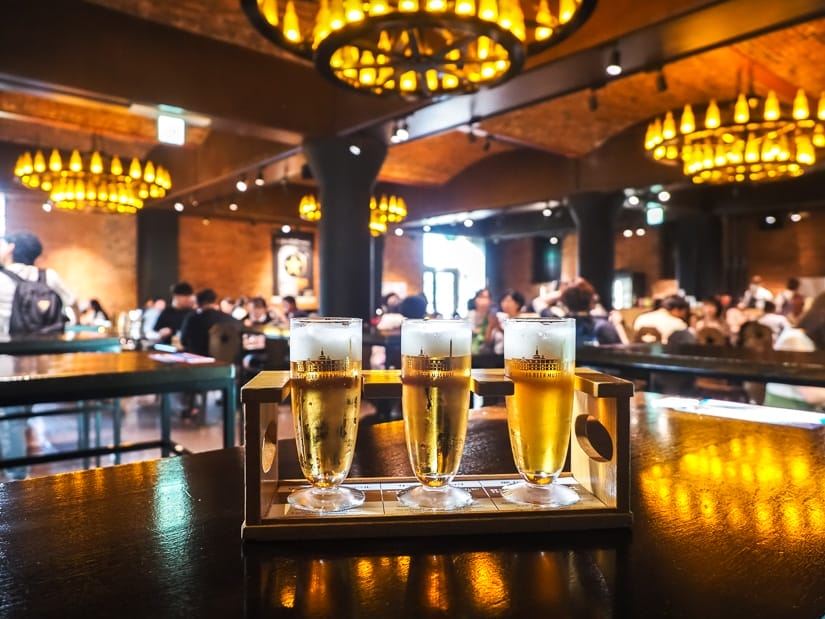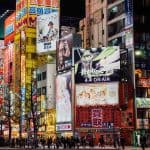Dear reader: This article contains links to products and services that I may be compensated for, at no extra cost to you.
Hokkaido is one of those regions that people tend to visit on their 2nd or 3rd trip to Japan, after they’ve checked off the big-name destinations like Tokyo, Kyoto, Osaka, and Mt. Fuji.
That was exactly the case for us, as this was our fourth trip to Japan. After spending a week taking our kids to Tokyo and then Tashirojima Cat Island, we added one week in Hokkaido. We intended to rent a car, get off the beaten track in the countryside, and experience some of the raw natural beauty that Japan’s least densely populated island is famous for.
In our seven-day Hokkaido itinerary, we took a laid-back approach, spending two nights in each spot, and road tripping around in our trusted Toyota Roomy. After the crazy amount of walking we’d done in our first week in Japan, this was a refreshing way to spend our second week.
In this article, I’ll introduce our Hokkaido 7-day itinerary day-by-day. We’ll be visiting traditional onsens, active volcanoes, a winery and cheese factory, seafood markets, and fields of colorful flowers. We’ll also be trying some of the most unusual soft serve ice cream flavors in the country!
Table of Contents
Best Time for a Hokkaido Road Trip
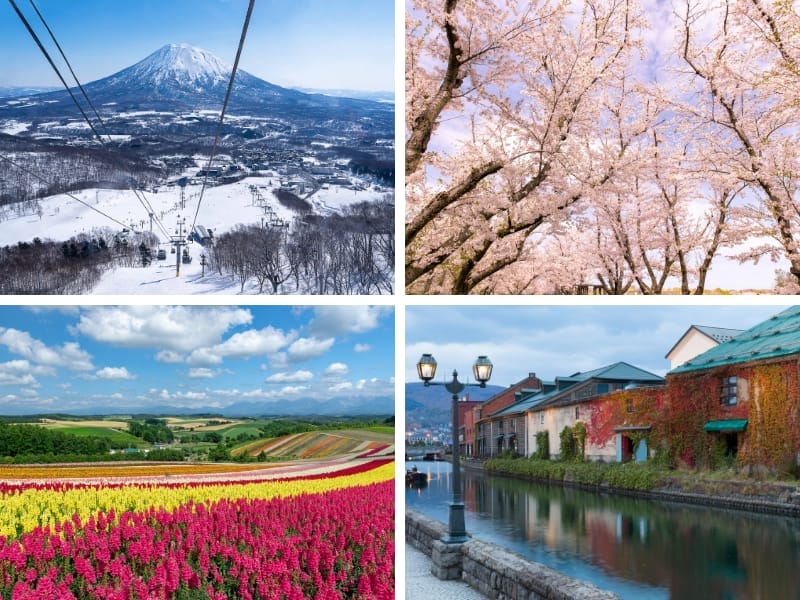
Hokkaido has a colder climate than other parts of Japan. In winter, people visit it to go skiing and for the popular Sapporo Snow Festival (see more info in my guide to visiting Japan in winter!) Planning a visit at this time would be very different than what we experienced. We have enough snow at home in Canada, so we are good on that!
Cherry blossoms don’t bloom until May in Hokkaido. When this coincides with Golden Week in Japan, you can expect serious crowds in Hokkaido.
But the best time to visit Hokkaido is summer. This is when the weather is warm, generally clear, and the island’s famous fields of lavender and other flowers bloom in the farmland around Furano and Biei. It’s also the best time for trekking in the high mountains.
The ideal weather and flowers also make Hokkaido a very popular and crowded destination in summer, especially among Asian tourists and Japanese looking to escape the heat in other parts of the country.
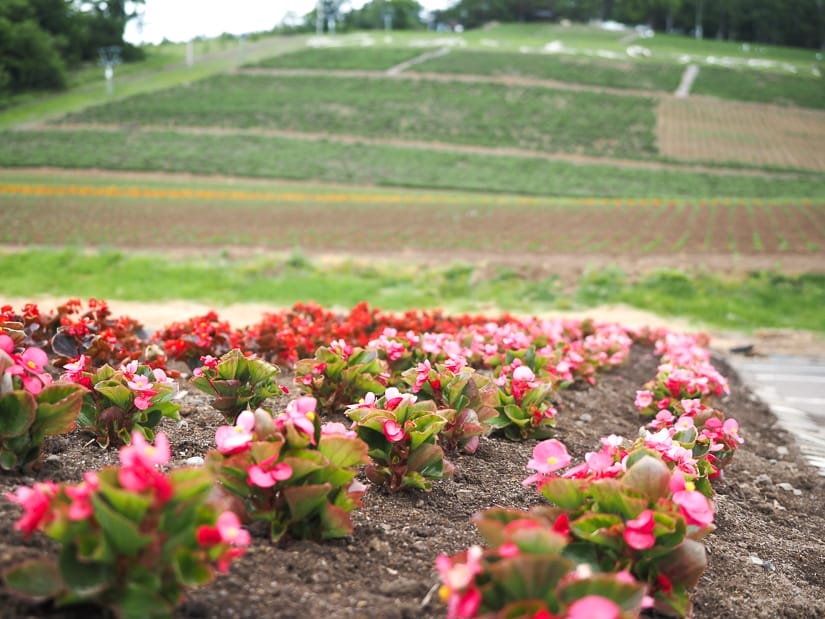
For our trip, we went in June, which is a shoulder season between cherry blossoms and summer. We chose this month because we had to be back to Canada for summertime.
While we appreciated the lack of crowds, if I could go again, I would go to Hokkaido in summer. The weather wasn’t great on our trip, with gray skies or light rain for 6 out of 7 days. The flower fields were only just starting to bloom but weren’t so impressive yet.
And when we took the gondola up Asahi-dake (the tallest mountain in Hokkaido), there was still so much snow that couldn’t do the hike we’d planned. Therefore, even if it means contending with thick crowds, if we ever returned to Hokkaido, we’d definitely go in summer, even if that means contending with bigger crowds.
Things to Know about Driving in Hokkaido

Hokkaido was only the second time in my life that I’ve driven on the left side (of the road) or right side (of the car).
It’s definitely a weird adjustment to make at first, but you get used to it quickly. Driving on the opposite side of the road was easy enough. But what I kept doing was accidentally turning on my windshield wipers when I wanted my turn signal! I also found myself constantly driving too far to the left in my lane and had to repeatedly correct it.

We rented a Toyota “Roomy” because we wanted a very Japanese-looking cube-shaped vehicle. The kids loved it and dubbed it our “Vroomy”. It was indeed very spacious inside.
Renting on the Toyota website, picking up the car, and paying with credit card was a breeze. Usually I rent cars on 3rd party platforms like RentalCars or Klook, but in this case I found that the direct Toyota site had the best options because it is so widespread in Japan.
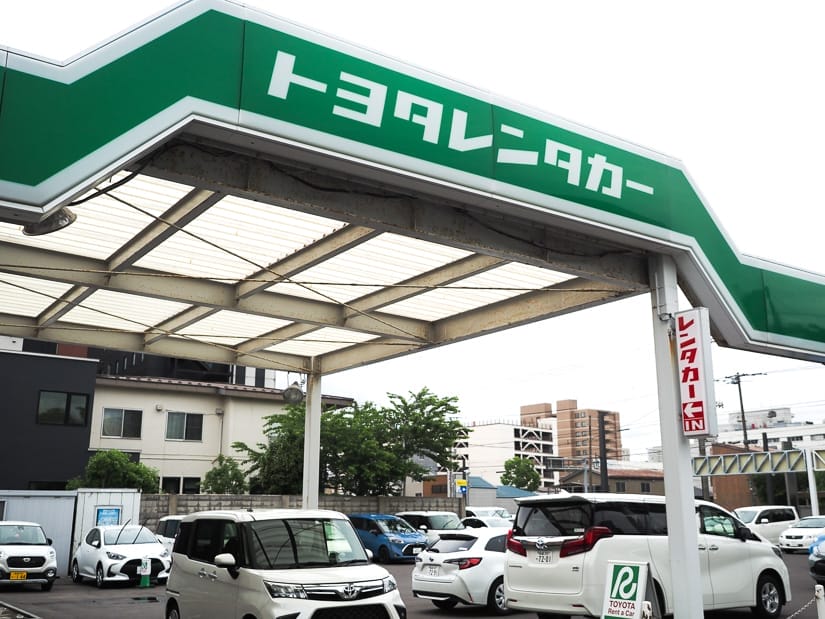
I suggest watching the instructional videos on the Toyota site before renting. It’s a good idea to learn the different street signs before you try driving, as they are different than other countries.
I felt like starting the car rental in a small city (Hakodate) was very smart, rather than starting in a big city like Sapporo. Since we finished our road trip in Sapporo, by the time we got there, I was basically a pro at driving in Japan.
Having said that, overall, I found the traffic to be extremely easy to navigate in Japan. People generally drive slowly and very carefully. This is a big change from where I lived in Taiwan for 10+ years. If you have to start your road trip in Sapporo, you’d be fine.
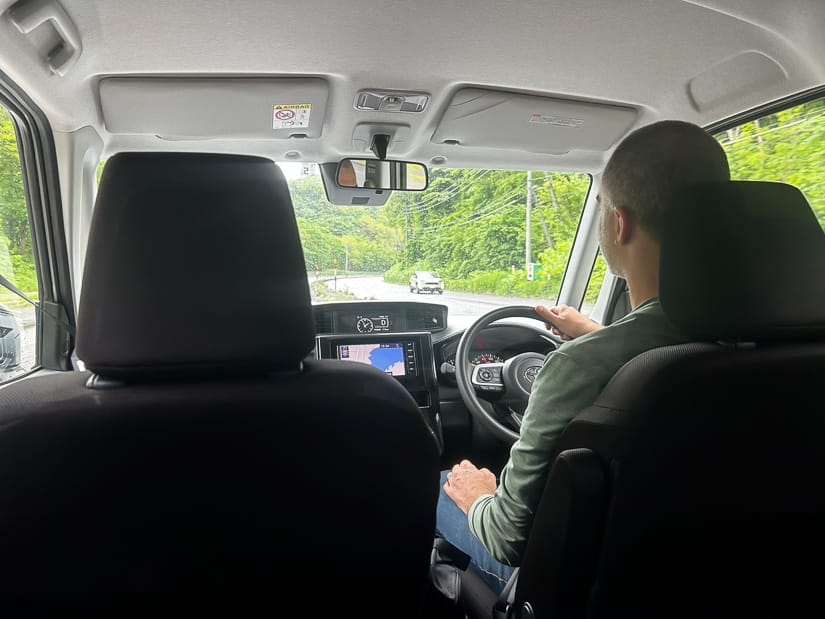
One thing we wish we had was a cell phone holder so I could navigate with GoogleMaps on my phone. The in-car navigation system sucked. Emily had to hold the phone and direct me, which was less than ideal (without exception, she always told me to turn AFTER I passed the turnoff). Next time, I would bring one from home.
The car came full. Filling it up with gas was super easy. Stations can be self-serve, but every one we went to had attendants. You can look up how to say it in Japanese, but I’d just say “regular”, “credit card”, and “full” in English and they understood me every time.
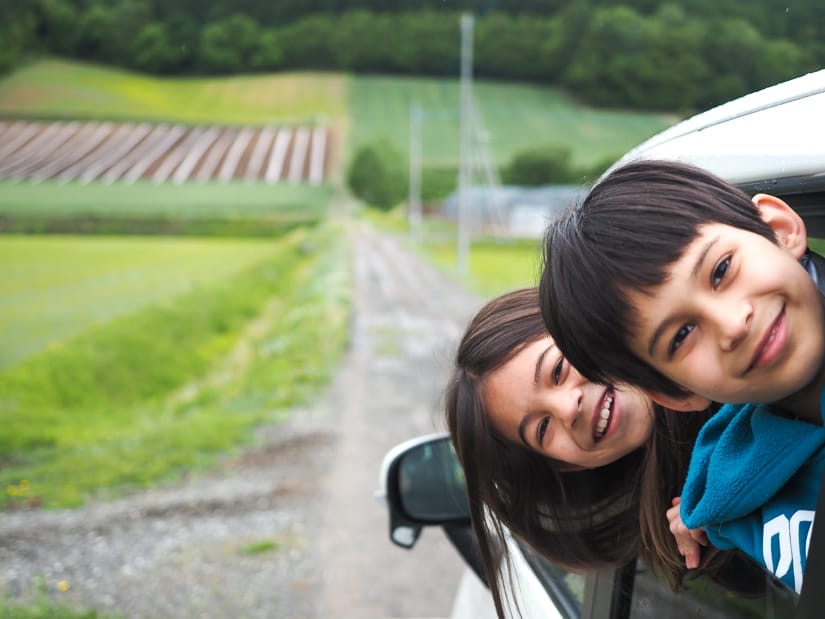
One other thing to know about is that there are many highway tolls in Hokkaido. Every time we drove between cities, the highway had tolls, and they weren’t cheap (it worked out to roughly 1000 yen per hour of driving).
We paid these tolls in cash, only to notice later than our car had an ETC (electronic toll collection) sticker on the dashboard. This means we probably could have just driven through the automatic line and paid the fees when we returned the car.
They never mentioned this when we got the car, but I suggest you ask about it when renting. This would have saved us a little time at the machines every time we entered and exited the major highways.
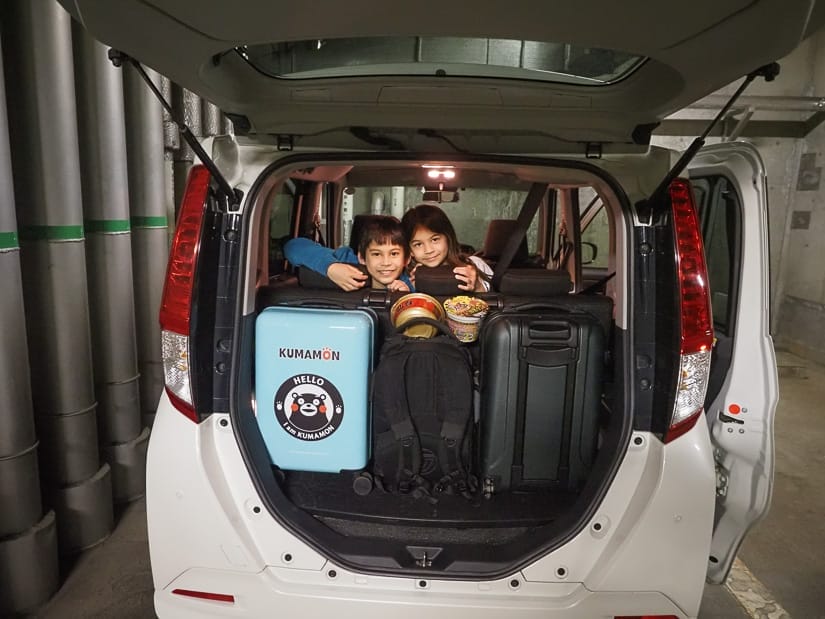
On a few drives, we purposely took slower routes to avoid the tolls, but they were sometimes quite a bit slower. We did this not only to save but also to enjoy the scenery.
Every hotel we stayed at had parking, sometimes free and sometimes for a fee, except for the hostel we stayed at in Sapporo. If you’re starting your trip in Sapporo, consider to explore the city on foot and by public transportation first, then get your car rental when you’re ready to leave the city.
Summary of Our 7 Day Itinerary
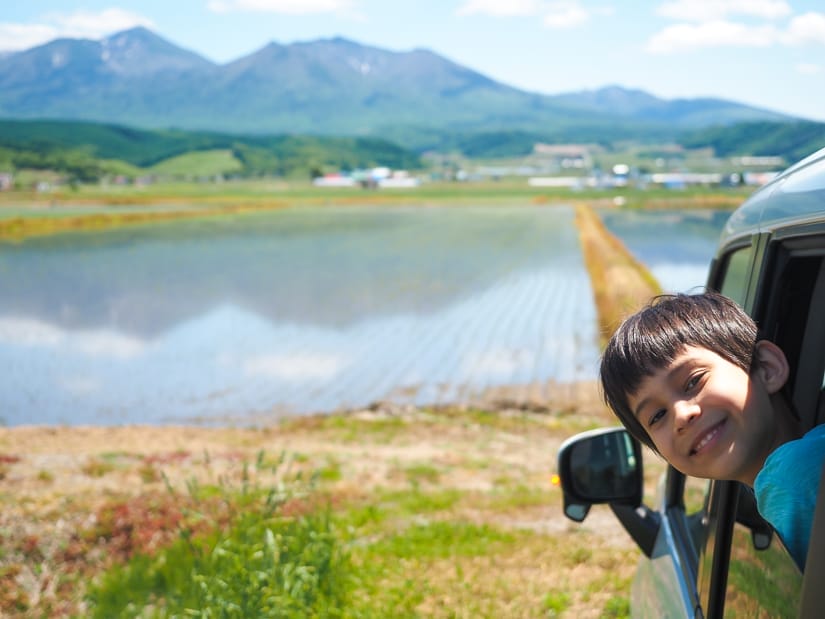
It’s important to note that we arrived in Hokkaido by shinkansen (bullet train) from Honshu (the “main island” of Japan, where Tokyo is). Note: we booked our shinkansen tickets on Klook, which allowed us to book them before the tickets were even released!
The main reason we chose the Shinkansen (which is more expensive than budget flights) from Tokyo to Hokkaido is that we wanted to stop at Tashirojima Cat Island on the way.
The shinkansen line terminates at Hakodate, a small city at the southern tip of the island, so that’s where we started our Hokkaido road trip. It doesn’t go all the way to Sapporo.
Here’s what our itinerary looked like:
- Hakodate (1 night)
- Noboribetsu Onsen (2 nights)
- Furano and Asahidake (2 nights)
- Sapporo (2 nights)
We actually stayed in Hakodate for 2 nights, but we arrived in Hakodate very late at night, so I didn’t count that first day in this 7-day itinerary. If you arrive earlier in the day, 1 night is enough for Hakodate.
If you’re flying into Sapporo, you could basically do the opposite from us:
- Sapporo (2 nights)
- Furano and Asahidake (2 nights)
- Noboribetsu (2 nights)
- Hakodate (1 night)
From Hakodate, you could then drive back to Sapporo’s New Chitose Airport (3.5 hours) and end your car rental there, or hop on the Shinkansen for traveling south to Honshu.
Day 1: Hakodate

Hakodate is a port-city near the southern tip of Hokkaido. The city is known for its morning seafood market, European-architecture (including a star-shaped fort), and the nighttime view looking down on the city from Mount Hakodate.
As the northern terminal end of the Shinkansen, we got off the bullet train and started our car rental here.

Since we arrived on a very late bullet train, we actually stayed in Hakodate for two nights, which gave us one full day there. Our first Hokkaido surprise when we got off the train in Hakodate was: it was cold! We’d been wearing shorts and t-shirts even at night in Tokyo, but Hakodate was around 10 degrees colder.
After crashing at Premier Hotel Cabin Presidente (see on Booking / Agoda) right next to the train station, we started our Day 1 where everyone should: at the Hakodate Morning Market.
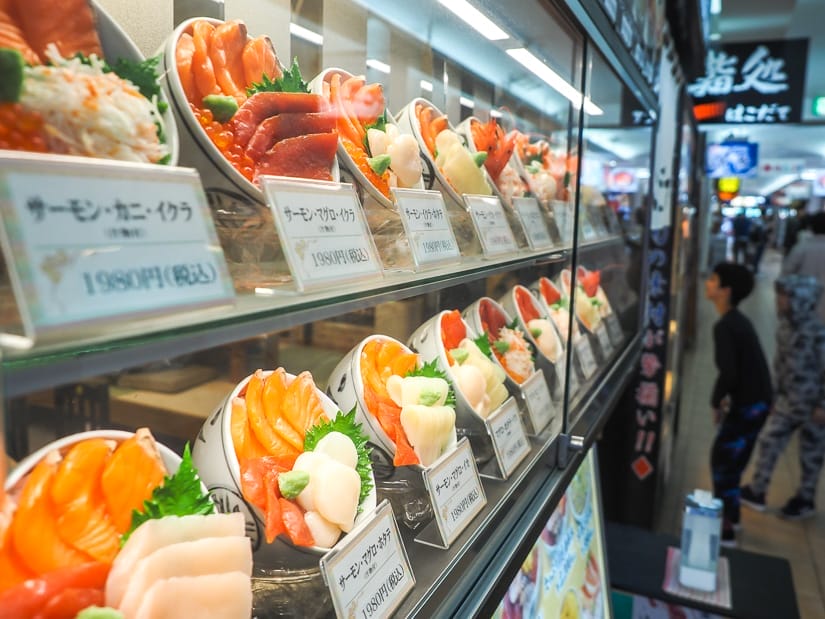
Having just come from Tsukiji Morning Market in Tokyo, which is extremely touristy and overpriced, we liked this one much better. It had more a local vibe and the food prices weren’t quite so outrageous.
In the market, we saw tons of Hokkaido’s main specialties: crabs, sea urchins, scallops, fish eggs, and squid. There was even a large squid tank in the middle of the market when people can catch their own squid (we took a pass on that…)
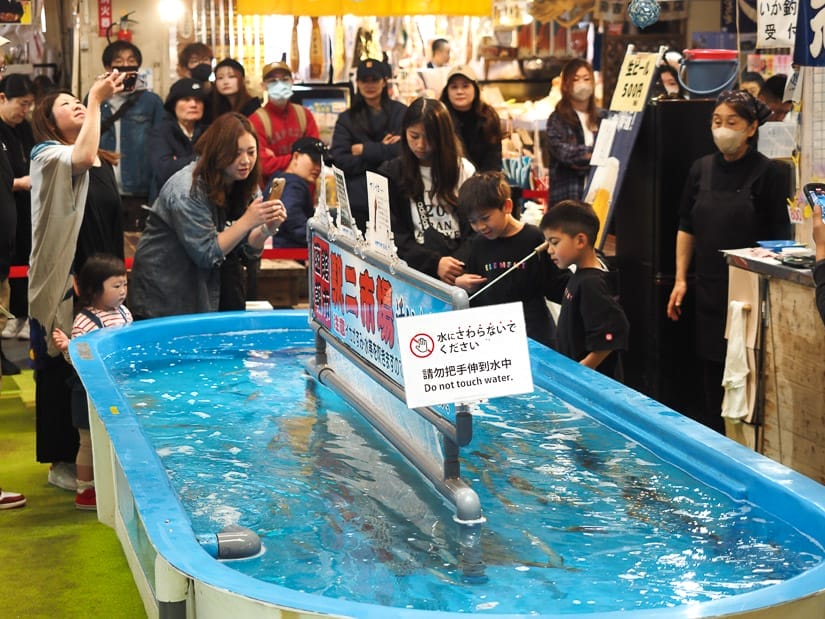

After much deliberation over the multitudes of plastic food models in the windows, we finally choose a spot for seafood breakfast. I recommend the local specialty Hakodate tomoe don (sea urchin, scallops, and fish eggs on rice) or anything with ikasomen (raw squid strips), a local Hakodate specialty.
In the adjacent dry goods market, you can also find slices of melon, another Hokkaido specialty which we’ll be seeing a lot more of on this trip.



After breakfast, we walked a few blocks to the Toyota car rental shop here to pick up our car rental. We’d reserved this in advance on the Toyota Car Rental Site and we paid with credit card on site.
To get used to driving in Japan, we made a simple half day trip to Onuma Quasi-National Park, which is only a 40-minute drive from the city. The park has a network of walking paths with many small bridges connecting islands on a lake with an active volcano on the other side.
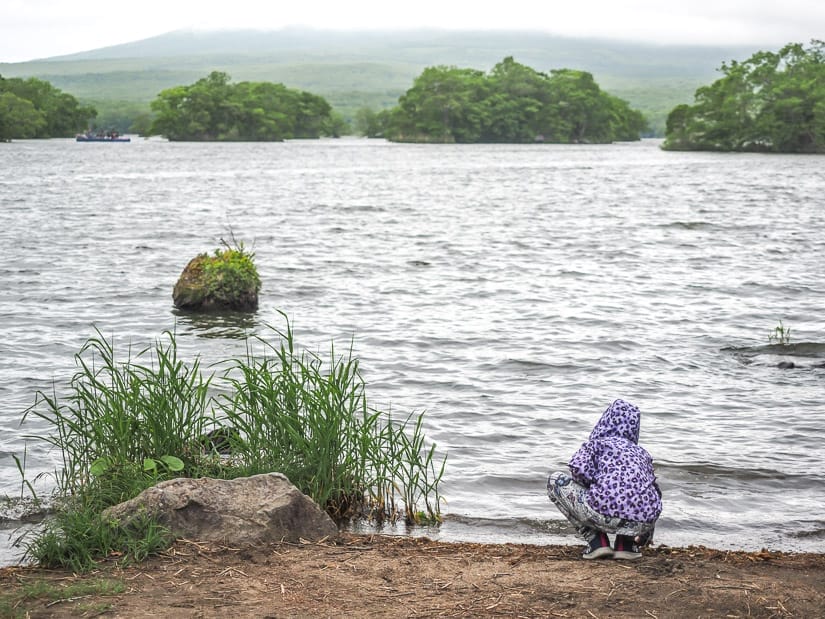
Onuma wasn’t as impressive as some parks we would later visit in Hokkaido, so I don’t really consider it a must-visit. The weather was quite junky when we visited, so we couldn’t really see the volcano. In better weather, it would be a lovely spot for an easy stroll.
The highlight of our visit was the various flavors of soft serve (melon, matcha, squid ink) at the shops beside the lake.

Returning to Hakodate, we had big plans that never materialized. I wanted to visit Tea Shop Yūhi (here), a traditional teahouse overlooking the sea, but it turned out they were on break.
We also planned to visit the Former British Consulate, drive up this picturesque street, and finish with the famous city view from the top of Mt. Hakodate. However, the gray, rainy weather killed our desire to do any of this.
Instead, we ended up passing a few hours in some local supermarkets and stationery stores. The next thing we knew, it was dinnertime, so we returned the car to the hotel and walked to Daimon Yokocho (here), a super cute narrow lane of traditional restaurants.
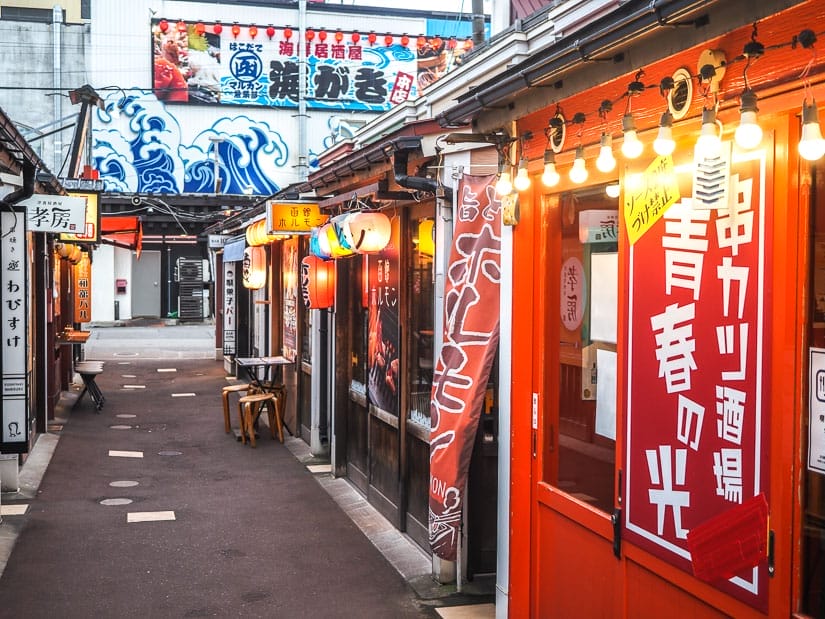

We had our hearts set on Crab House but found that, like many restaurants on the street, it was TINY (many places only have room to seat 4-8 people!) and full, so we ended up just choosing a restaurant that had space for us.
To finish our night, because we’d missed the famous Mt. Hakodate view, Emily and I instead let our kids play video games in the room and snuck out for a date night at our hotel’s bar, which had a pretty fantastic city view. We could even see the lights of the Hakodate gondola station and little gondolas ascending to it (see photo below).

Days 2-3: Noboribetsu

On Day 2, we drove (3 hours) from Hakodate to Noboribetsu, one of the most famous onsen (hot spring) villages in Hokkaido.
Only the way, we made a brief detour to this epic viewpoint of Lake Toya. This is a huge, circular caldera lake with an island poking up in the middle. This was our first instance of sheer awe with Hokkaido’s grand landscapes.
The viewpoint is free to visit. There’s a café, souvenir shop, restrooms, and scenic helicopter rides over the lake available on site.
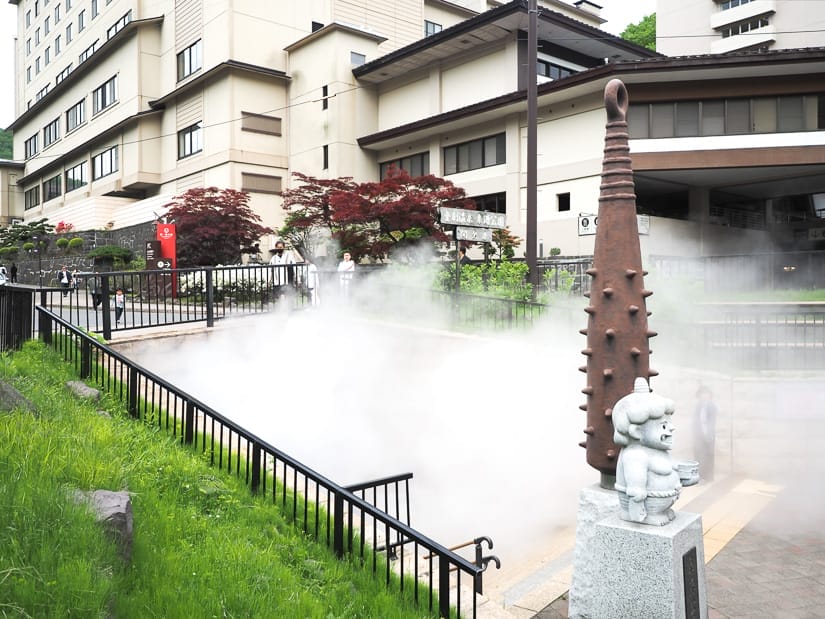
Noboribetsu was our biggest splurge in Japan. We spent two nights at the enormous Dai-ichi Takimotokan (see on Booking / Agoda) onsen resort. This was our most expensive stay in Japan, especially once we added the breakfast and dinner buffet (we only added it for one of our nights to balance the cost).
The cost, however, was absolutely worth it and staying here was one of the highlights of our Hokkaido trip. For starters, the resort has the best location, literally overlooking Noboribetsu Jigokudani Valley (Hell Valley), an active volcanic crater, the most famous attraction in town.

Second, the resort is super family-friendly, with a large mixed-sex (bathing suits) swimming complex, including waterslides, swimming pool, and hot tubs with crater views. It also has huge sex-segregated (nude) onsen areas, with indoor and outdoor pools – the outdoor one even has a sake bar.
Our kids loved choosing their own traditional robes when we checked in. We also had amazing sleeps on our individual tatami beds, after several nights of staying in regular hotels with tiny double beds.
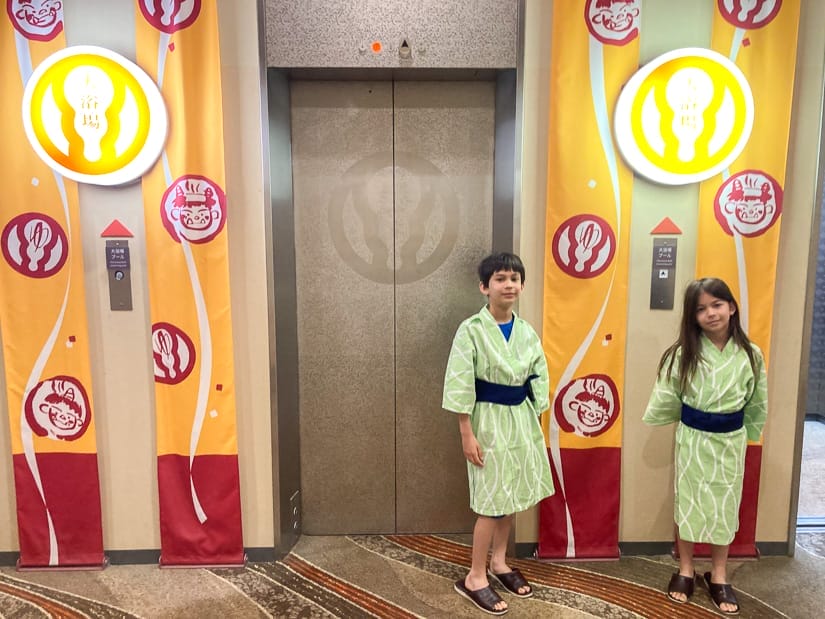


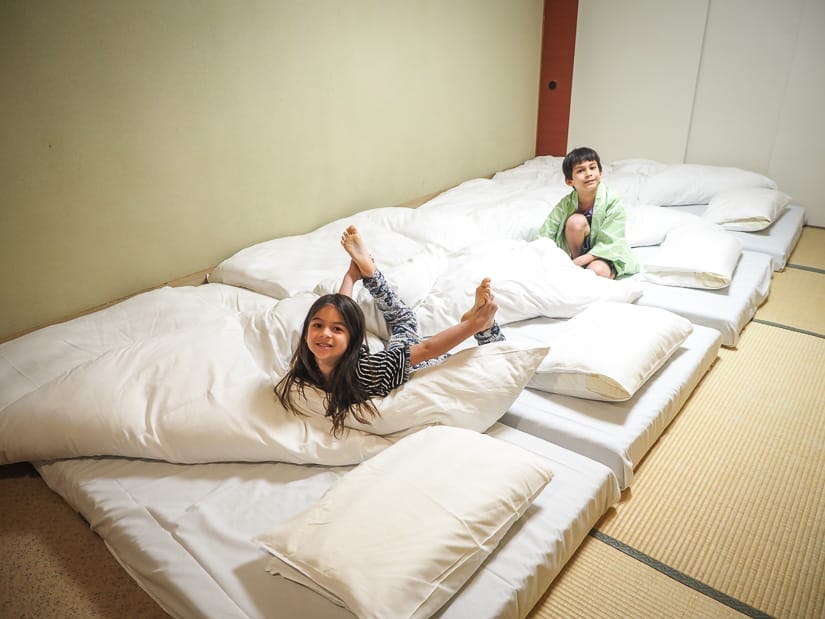

The resort also has a games room (coins needed), convenience store, and ramen restaurant inside.
On Day 2, we just enjoyed the facilities at the resort. On Day 3, we followed the free walking path through Hell Valley, marvelling at the steam vents, volcanic fumaroles, and brightly colored mineral deposits. It’s worth noting that you can also walk through at night, when the paths are illuminated.

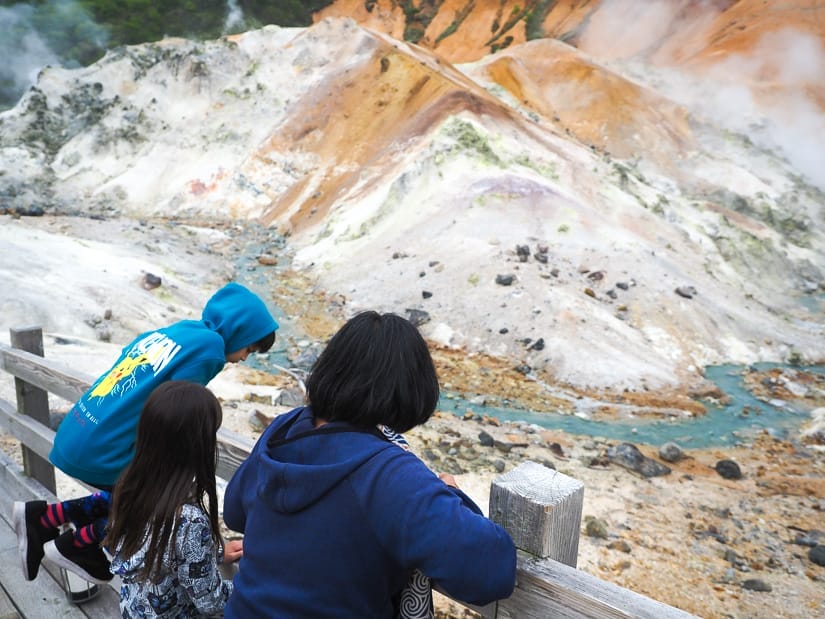
From Hell Valley, we followed this trail to Oyunuma Lookout and Oyunuma Pond, a large steaming hot spring pond. The kids enjoyed guessing the answers to the quiz questions posted on signs along the trail.

From Oyunuma Pond, we walked to River Oyunuma Natural Footbath (here), where we enjoyed soaking our feet in the hot creek next to a small waterfall.
Despite the proximity to so many huge resorts in Noboribetsu, the trails were relatively quiet and crowd-free.

Day 3 is the night we had paid for the buffet dinner and breakfast. The dinner buffet was a true extravaganza – I’ve never eaten so much in one meal in my whole life. Notably, the buffet includes all-you-can-eat giant crab legs, fish roe, various types of sashimi, and dozens of other Japanese and international dishes.
The kids’ favorite part was of course the self-serve melon soft serve ice cream.
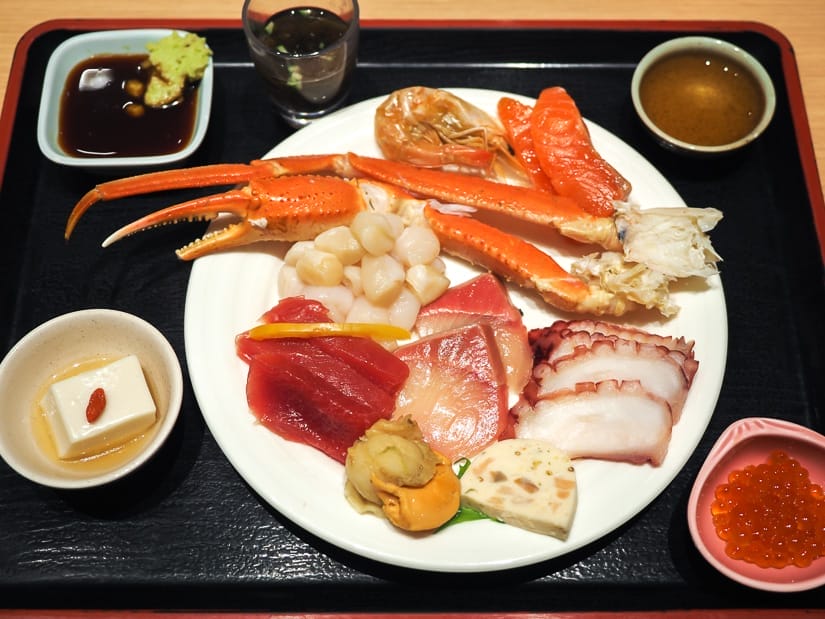

I was still full the next morning, but we got up and did it all again with the enormous breakfast buffet.
Even though it literally doubled the price of our room for that night, we’ll never forget those two buffet meals, so it was worth the cost for us.
You will notice a variety of hot spring demon statues around Noboribetsu and on many of its souvenirs. There’s also an animatronic god statue here on the little tourist street in front of the resort. At some set times every day (there’s a sign with the times), he briefly changes into a demon.
There’s also a gondola in Noboribetsu which goes up to a bear park (with real live Hokkaido bears in cement cages – we had no interest in this) and a view of the perfectly round Lake Kuttara crater lake. We read that they sometimes even use one of the gondola cars to dry fish for the bears, and you can see it going by when you go up!
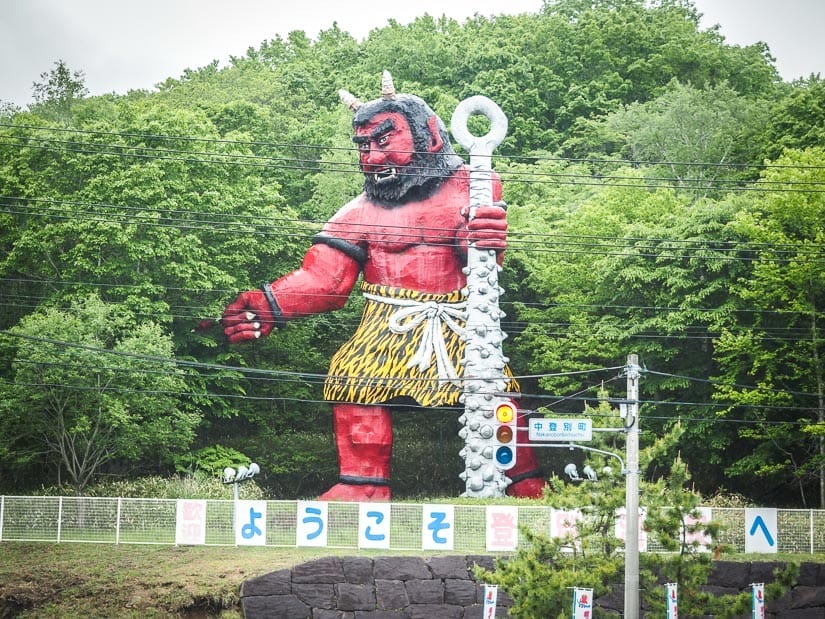
Days 4-5: Furano and Asahidake
On day 4, we drove (3 hours) from Noboribetsu to Furano, our third stop in Hokkaido. Furano is a ski town in winter and famous for its lavender and rainbow-colored fields of flowers in summer.
The biggest surprise for me was how much the Furano region (and Hokkaido in general) reminded me of home (Canada), specifically British Columbia. As we drove through the countryside, with hot springs, fields of flowers, fruits, dairy farms, wineries, pretty lakes, and mountain views beyond, there were moments I could have sworn we were in the Lower Mainland of BC – except with rice paddies.
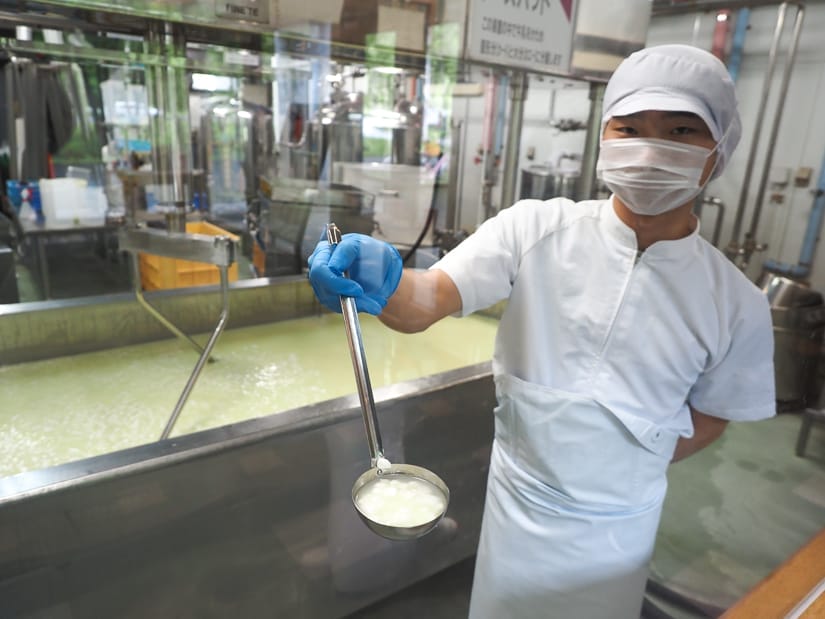
Our first stop in the area was Furano Cheese Factory. There we got to sample local Furano cheeses (including a black squid ink cheese!) and watch the cheese being made. For lunch, we had a wood-fired pizza finished with cheese-flavored soft serve ice cream.
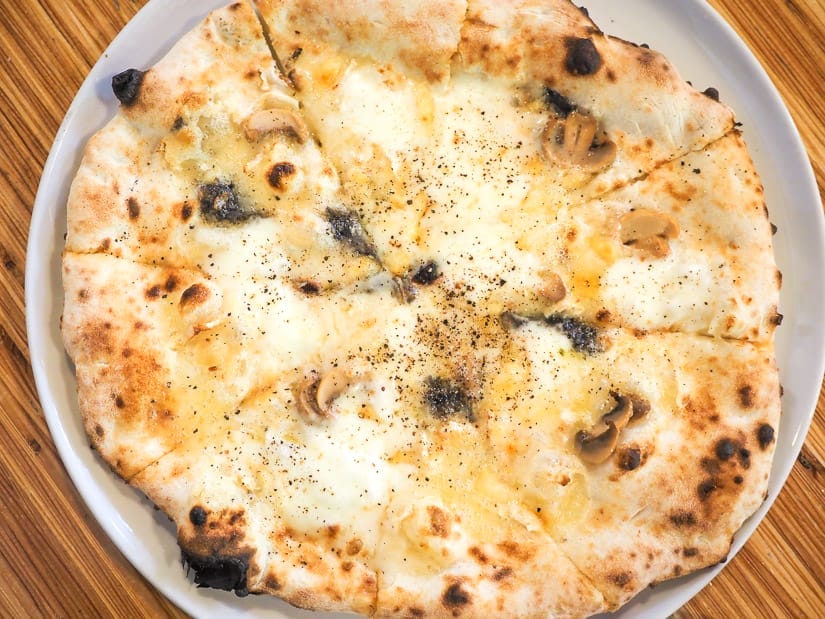

There were also DIY ice cream and butter making classes, but we didn’t join because we just missed one and the next one wasn’t for a few hours. In the shop on site, there are a variety of cheeses, butter, and creamy desserts for sale.
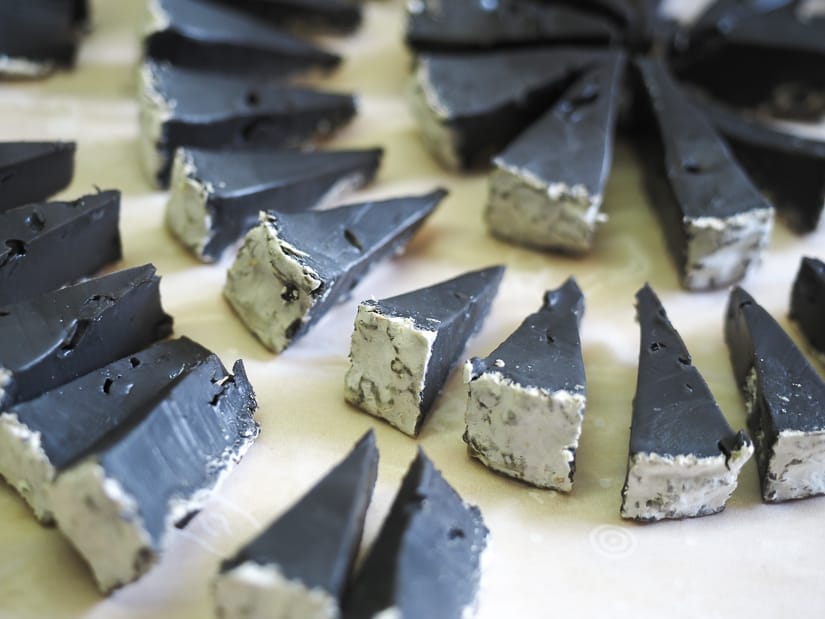

Next, we moved on to Furano Winery on a hill overlooking town. Without charge, you can visit the winery’s cellar, grape and lavender fields, and sample 4 or 5 of their wines. For an added cost of 200 yen per sample, you can taste some of their more expensive wines with a real wine glass.

Emily and I were eager to try Hokkaido wines, but we have to admit we didn’t love them. The cheaper ones tasted like they had juice added to them.
The more expensive ones were passable, but for the price we paid for a bottle (around 25 USD), it simply was not on par with similarly priced wines from other regions. If you had a different experience with Hokkaido wines, please share it in the comments at the end of this article!
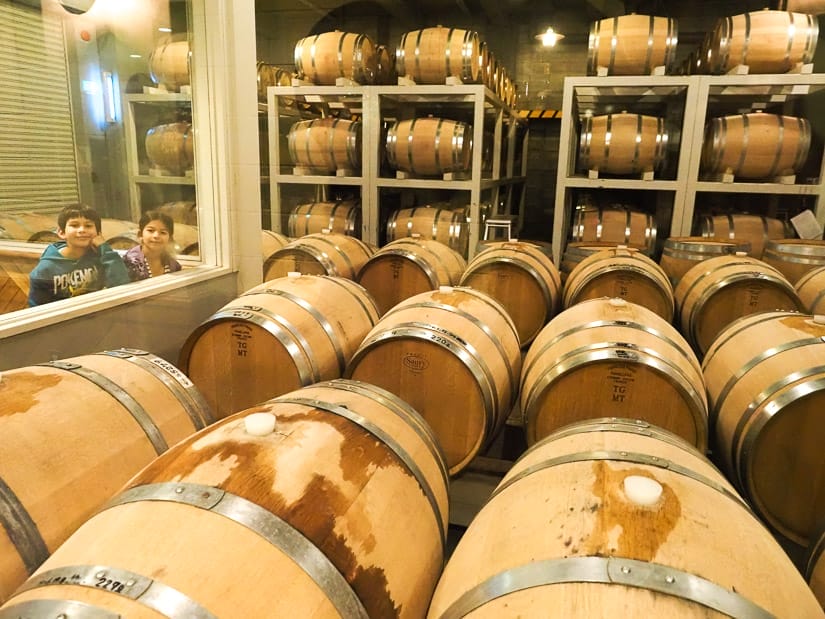
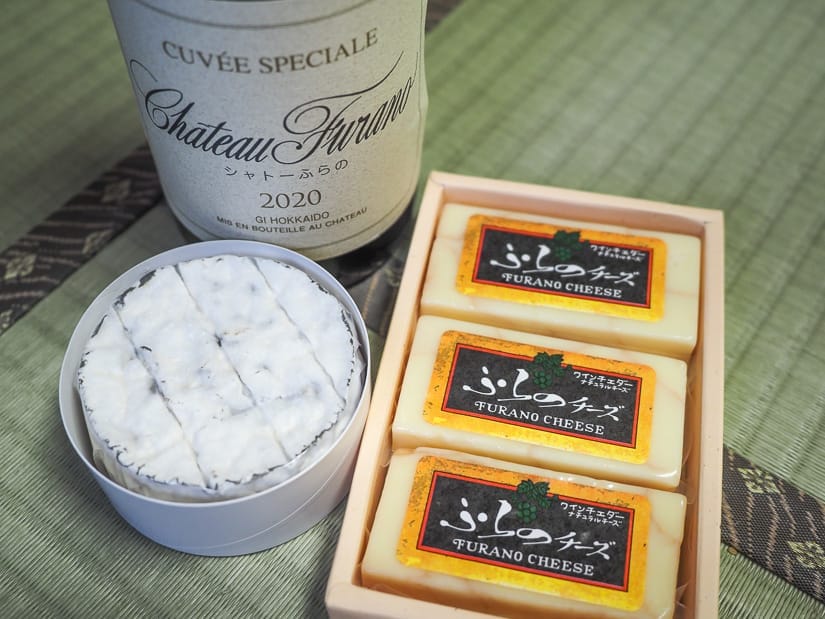
In Furano, we stayed in what we kept telling our kids was the “most traditional” hotel of our trip. Highland Furano (see on Booking / Agoda) is a typical local onsen hotel in the countryside 10 minutes-drive west of town.

We were too early for it, but the hotel overlooks a large field of lavender. We stayed in a traditional tatami room, with the only bathing option being the traditional nude bathhouse.
Although our kids were nervous about bathing nude in front of strangers for like 10 seconds, they very quickly become comfortable with it.

Day 5 was our biggest day of exploring Hokkaido by car. After enjoying the huge breakfast included with our room, we started the day by driving to Shirogane Blue Pond. The pond has a surreal turquoise color with trees reflecting on its surface.
And of course they had blue soft serve ice cream to go with it – it was soda flavored.
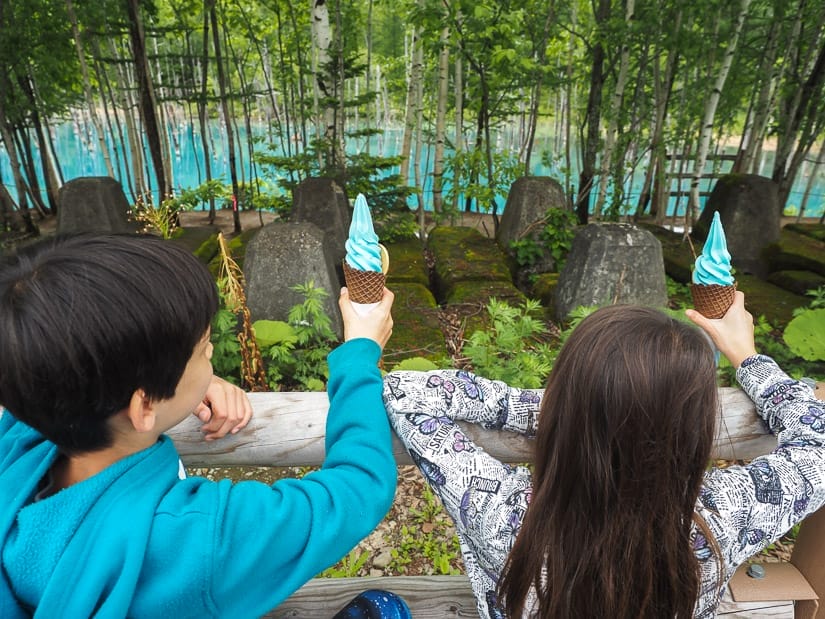
Nearby, we looked down on Shirahige Waterfall from a pedestrian bridge. The impressive falls plunges down a cliff into a river with the same color as the blue pond.

From there, we debated driving just a little further to go for a hike at volcanic Tokachidake Observatory, but it was almost lunch, so we returned to Furano instead. We made a stop at Goto Sumio Museum, which features the artwork of a renowned Japanese artist.
Sumio’s enormous, striking paintings cover the walls of the museum, featuring classical scenes of Japan and beyond.
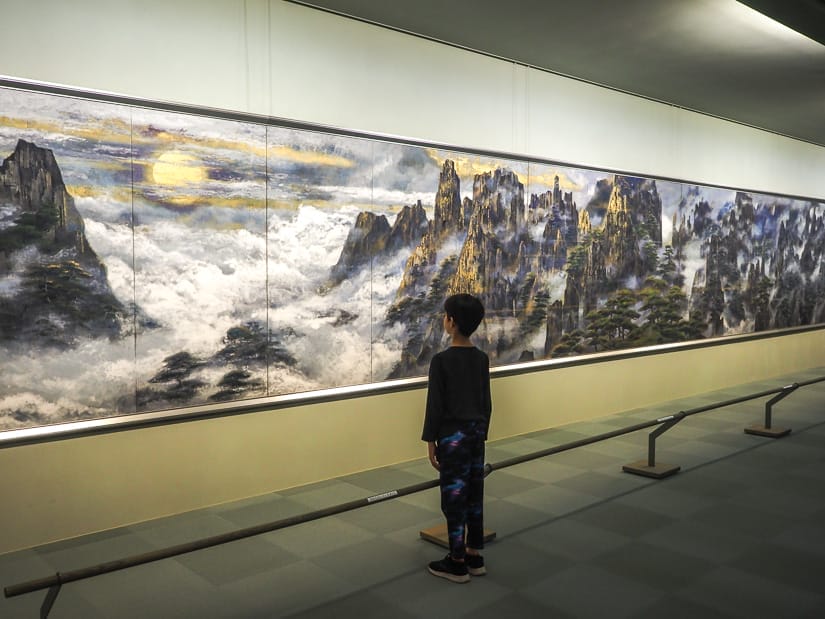
After lunch, we drove though Biei (Furano’s sister city also famous for flowers) and onward to Asahi-dake, the tallest mountain in Hokkaido (2209.9 meters).
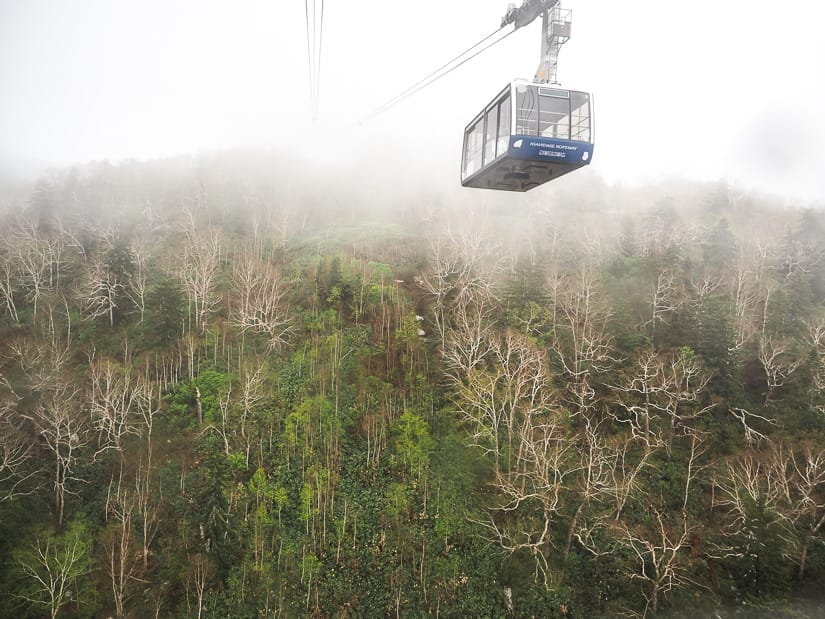
As we drove the winding road up into Daisetsuzan National Park, we knew we weren’t going to have the great views I’d been hoping for. It was a super foggy and overcast day. Still, we’d come this far and I was determined to ride the gondola up the mountain.
The Asahi-dake Ropeway takes off from here every 15 to 20 minutes. It’s not cheap (adults 3200 yen kids 1600), but since there are so many gondolas in Japan, we wanted to try at least one on this trip and this would be it.

On the 10-minute ride, we rapidly ascended into the clouds and enjoyed the limited views of the scenery directly below and next to us.
I knew it would be cold at the top (it’s pretty much the only reason we brought jackets to Japan, although we did end up using them every evening in Hokkaido).

However, what we didn’t expect is that it would still be winter up there in June! I knew to expect a bit of snow but didn’t realize there would still be so much of it.
The temperature when we got off the gondola was a chilly 4°C and the gondola station was surrounded by deep snow! I instantly abandoned my original plan to do a 2-hour hike from the ropeway station. Without proper winter boots, we wouldn’t be making it very far at all.

If you are from somewhere that doesn’t have snow, then this may be more exciting for you. For us, having just come from six months of snowy winter in Canada, this was just more of something we already have too much of.
My kids and I still went for a 20-minute walk to a small alpine lake. By the end of that, our feet were cold and wet, so we turned back.
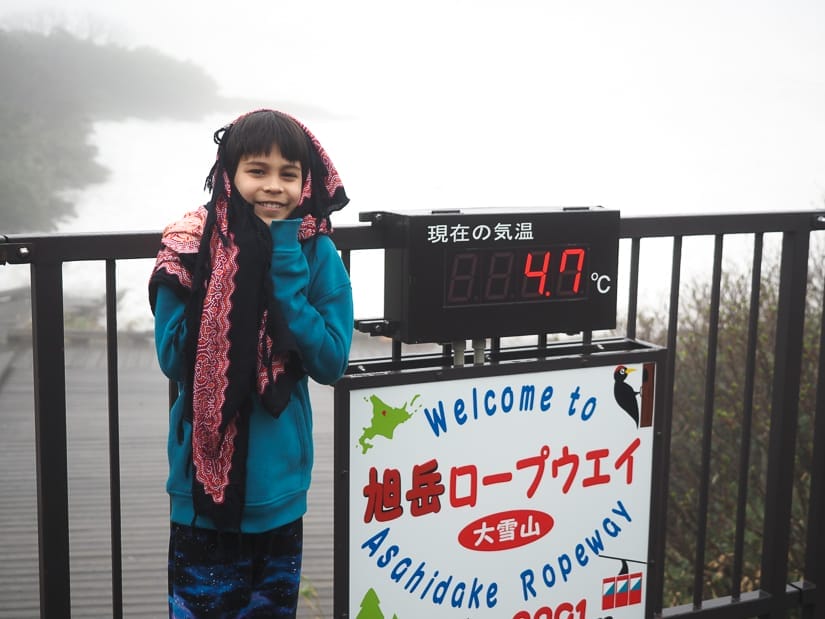
As you can probably gather, our Asahi-dake experience was not what we expected. The fog robbed us of any decent mountain views and the snow prevented us from exploring very far. If you visit on a fine day in summer, then it you would have an infinitely better experience than we did.
I had a much better experience visiting Koyasan in winter and hiking parts of the Kumano Kodo pilgrimage in winter – but that time I was prepared for it!
We actually had originally planned to stay at this hostel in Asahi-dake area instead of Furano, but it turned out they were closed for renovations. In the end, I’m glad we stayed in Furano instead because we enjoyed exploring that area so much and the weather wasn’t right for Asahi-dake.
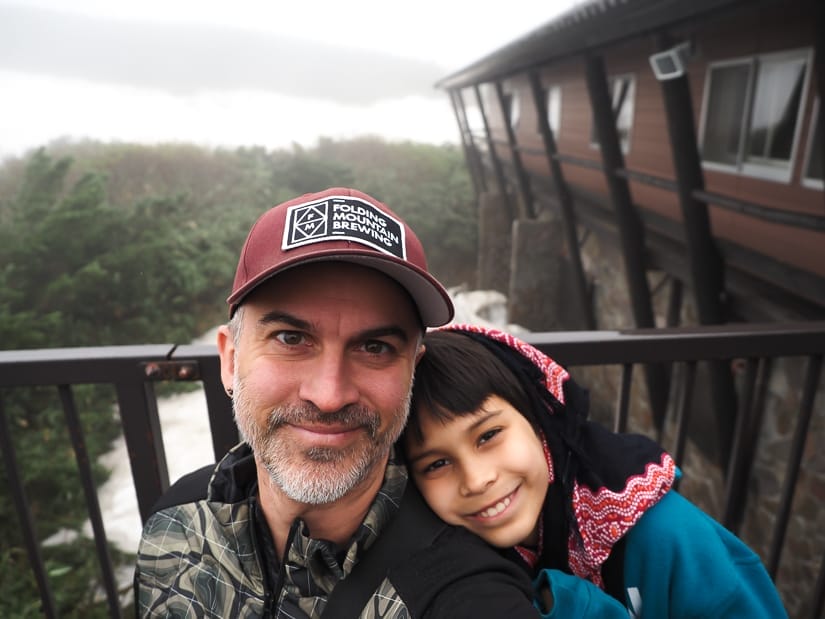
Day 6 to 7: Sapporo

On Day 6, we woke up to the most annoying of occurrences: now that we were leaving, it was the first day of our entire Hokkaido trip with lovely weather.
Thus, we dedicated half a day to exploring the flower farms around Furano before driving to Sapporo.

As I mentioned above, we were about a month too early for the main spectacle of lavender and other flowers at most farms. However, we still found quite a few flowers in bloom at Farm Tomita, one of the most popular flower farms in the region.
The lavender wasn’t blooming at all yet (but the lavender ice cream was available!). Many other fields of flowers were partially or fully in bloom. We felt very lucky that we got to experience this before leaving.

Next to Farm Tomita, we also visited Tomita Melon House, which sells ridiculously expensive slices of melon, whole melons, ice cream with melon, and so on.
We honestly found all the melon hype in Hokkaido amusing. The melons are so expensive (the priciest one we saw was USD 50 for one melon). And yes, they are good, but they didn’t taste any better than the melons we get in season in Canada or in Taiwan.
A few minutes away, there’s also a special summer-only “Lavender Farm” train station, with small tourist trains running over from town. We checked out the spot, but workers were in the midst of constructing the temporary station.
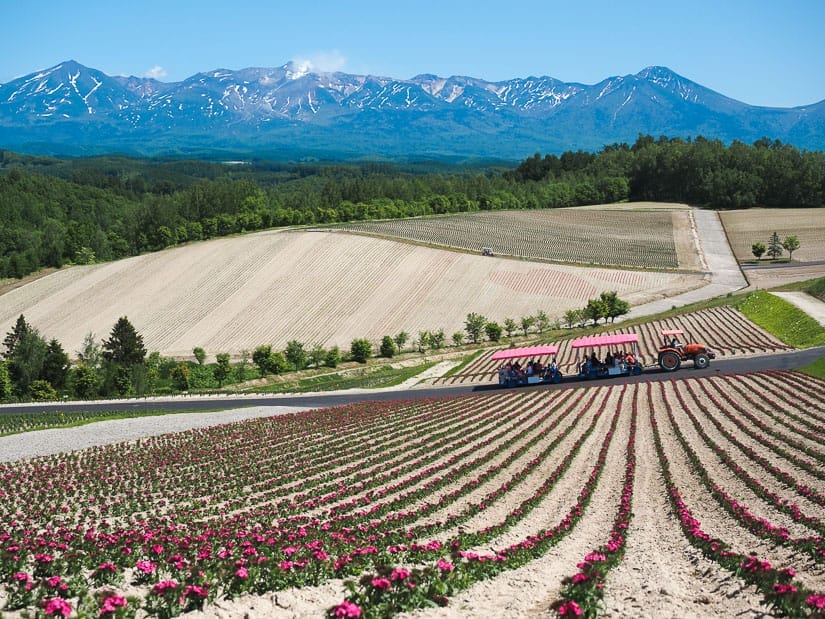
Before leaving, we wanted to squeeze in one more farm. For that we went to Panoramic Flower Gardens Shikisai-no-oka, which is between Furano and Biei.
There were even fewer flowers blooming at this one. However, in summer, it would be especially beautiful because the hilltop farm has expansive views of the surrounded area and all the way to Asahi-dake mountain in the distance. The farm is quite large, so they offer tours in trailers pulled around by tractor.
Satisfied now with our Furano flower experience, we drove to Sapporo. We decided to save a bit of money on tolls and take a slower (3 hours instead of 2) but more scenic route to the city. This was a lovely, winding drive through the countryside.

By the time we dropped off our car at the Toyota car rental station near Sapporo train station and checked into our private bunk bedroom at Plat Hostel (see on Booking / Agoda), it was time to eat.

For dinner, we made our way to Sapporo’s famous Ganso Ramen Yokocho Sapporo or “Ramen Alley”. The super narrow alley is lined with ramen shops dating to the 1950s. It may be touristy, but we really enjoyed it!
The massive bowl of cheese ramen (topped with a chunk of butter, a Hokkaido specialty – I ordered double butter!) I had at this shop was the best ramen I’ve ever had. The shop was very friendly to our kids, too, and even offered to take a family picture of us.
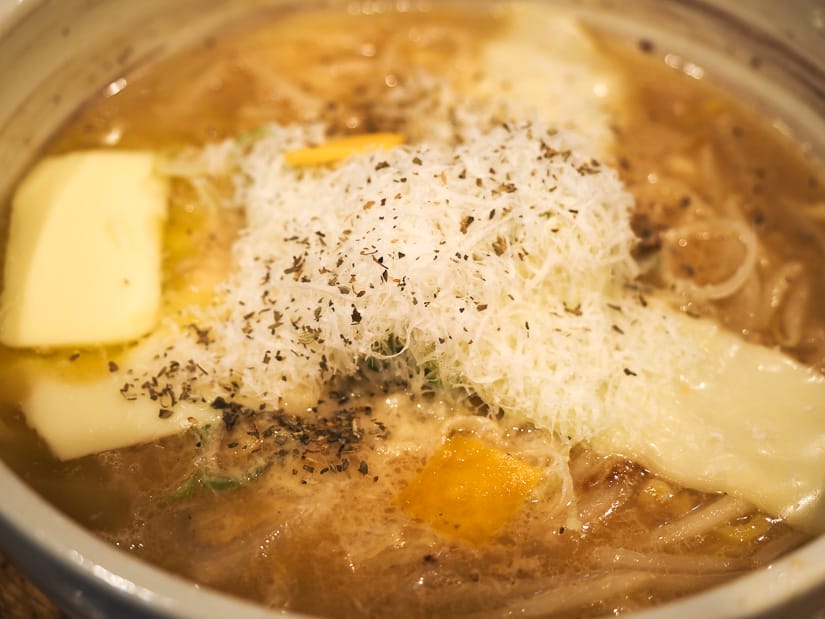

After dinner, we couldn’t miss the iconic Nikka Whiskey Man, Asahi beer, and olher neon billboards at the Susukino intersection nearby.
For Day 7, the last day of our two-week trip in Japan, we started out with our final seafood meal in Japan at Nijo Market, which by no coincidence was right next to our hostel.
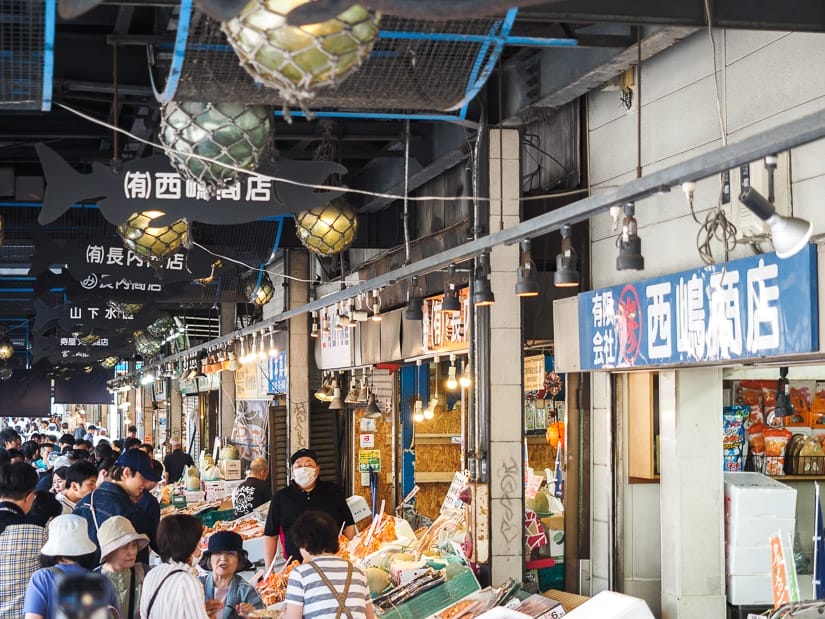
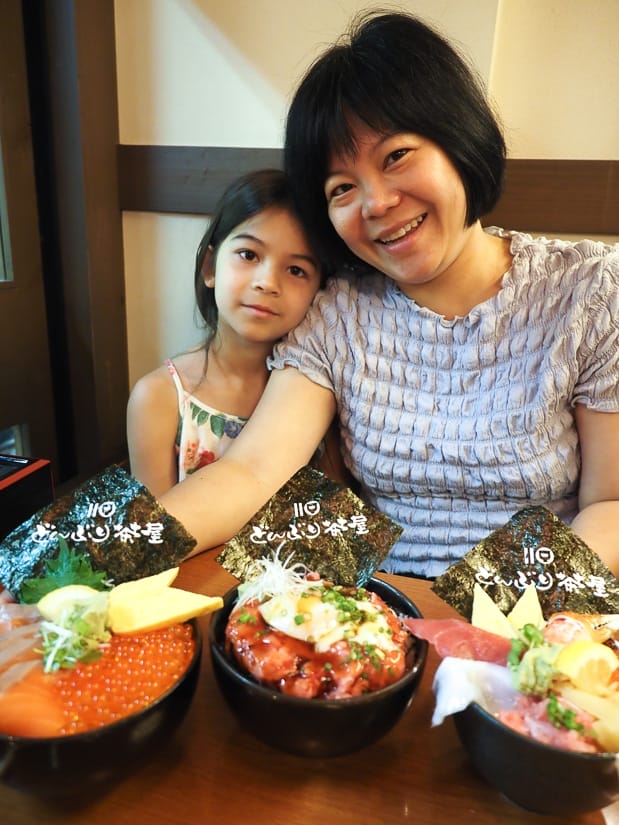

Next, we went to the long and skinny Odori Park, where the landmark Sapporo TV Tower stands at one end. There we were surprised to find groups of costumed dancers, who all seemed to be preparing or waiting for their performance time.
It turns out that we happened to be in Sapporo for Yosakai Soran Festival, where troupes of dancers take over the streets for days on end. We followed one of the troupes to find the street where they were performing and spent a couple hours watching the impressive performances.
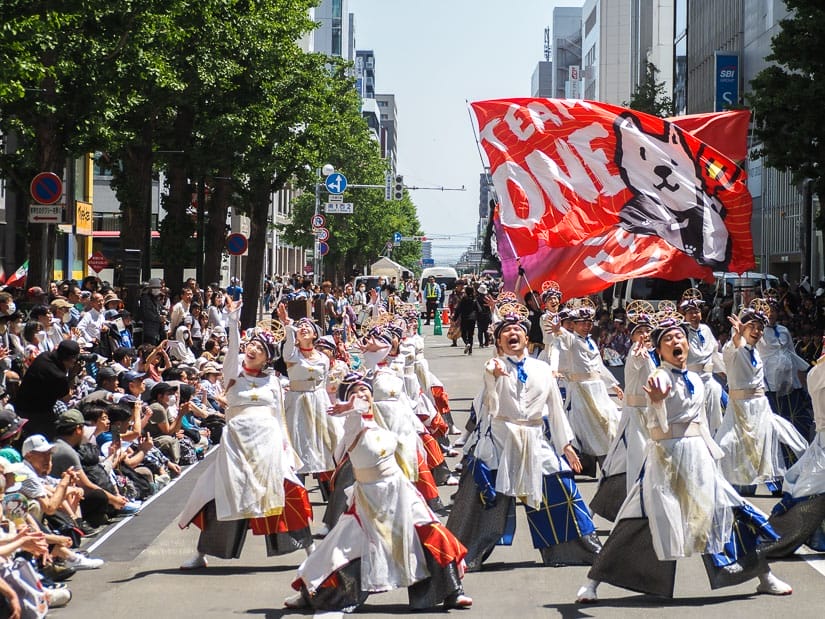
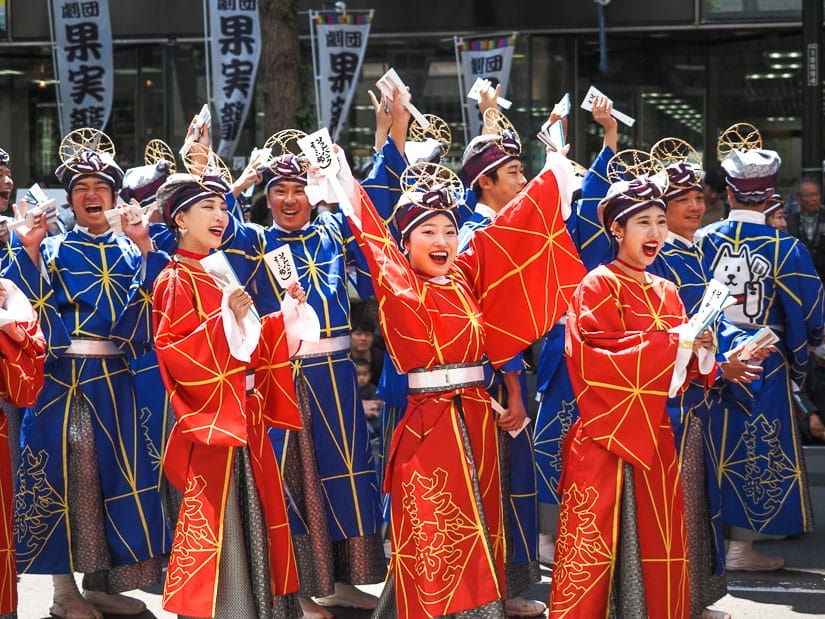
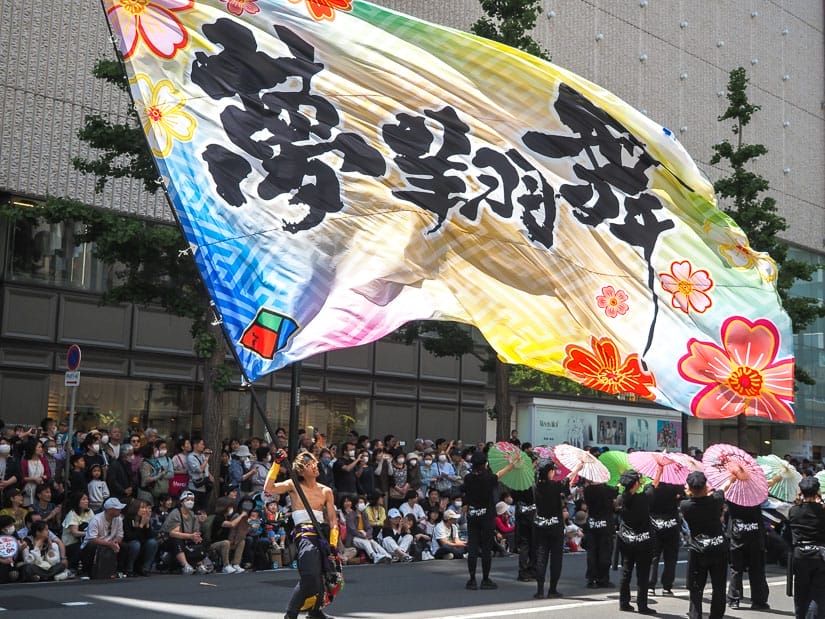
After that, there are more things we could have done in the city, but we had dedicated this final day to shopping.
We visited the tourist staple Mega Don Quijote, where you can buy almost anything a tourist would like to buy. Emily also hit up some clothing shops and my son and I finally managed to find a stuffy from his favorite video game (Battle Cats) after searching multiple nerd shops and department stores during our Japan trip.

The one must-visit for me in Sapporo was the Sapporo Beer Museum. It was a bit of a trek from the city center, but worth it to see Japan’s oldest brewery.
The handsome brick facility contains a small beer museum and tasting room, where you can order a sample tray with 3 types of Sapporo beer. You pay at a vending machine and can order little cheese bites to go with it.

We didn’t dine there, but there’s also an all-you-can-eat/drink beer and Jingisukan (lamb barbecue) restaurant on site.
Our final night in Hokkaido and Japan was uneventful. Thoroughly pooped and ready to go back home, we spent the evening with take-away takoyaki and trying to cram all the souvenirs we’d purchased into our luggage for the next morning’s flight!
